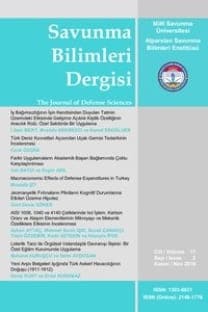Ses işaretleri için parametrik olmayan çok boyutlu bir modelleme yaklaşımı
A Nonparametric multidimensional modeling approach for speech signals
___
- Annadhason, A. (2012). Methods of Fractal Dimension Computation. International Journal of Computer Science and Information Technology & Security (IJCSITS). 2(1),166-169
- Benetsy, J., Sondhi, M.M. ve Huang, Y. (2008). Springer Handbook of Speech Processing. Berlin: Springer Press.
- Castanié, F. (2010). Spectral Analysis: Parametric and Non-Parametric Digital Methods. Wiley-ISTE: John Wiley &Sons Press.
- Fan, J. ve Yao, Q. (2005). Nonlinear Time Series: Nonparametric and Parametric Methods. Berlin: Springer Press.
- Grieder, W., ve Kinsner, W. (1994). Speech Segmentation by Variance Fractal Dimension. Proc. Of IEEE Canadian Conference on Electrical & Computer Engineering, 25-28 Sept.,Canada, 2; 481-485.
- Kraft, R. (1995). Fractals and Dimension. Technical Report. Munich, Germany: Munich University of Technology
- Mischaikow, K. ve Mrozek, M. (1995). Chaos in the Lorenz Equations: A Computer-Assisted Proof. Bulletin of the American Matematical Society, 32(1), 66-72.
- Pawelzik, K. ve Schuster, H.G. (1987). Generalized Dimensions and Entropies From a Measured Time Series. Physical Review A, 35(1); 481-484.
- Peitgen, H.O., Jurgens, H. ve Saupe, D. (1992). Chaos and Fractals: New Frontiers of Science. Berlin: Springer Verlag Press.
- Siedlecki, W. , Siedlecka, K. ve Sklansky, J. (1988). An overview of mapping techniques for exploratory analysis. Pattern Recognition, 21(5), 411-429.
- Tekbaş, Ö. H. (2004). Karmaşık İşaret Analizi ve Çoklu-Değişinti Kırılca Boyutu Modellemesi Yoluyla Telsizlerin Kimlik Tespitinin Yapılması. (Yayımlanmamış doktora tezi), Ankara Üniversitesi, Ankara
- Yıldırım, Ü. (2009). Fraktal Modelleme ile Ses Parmak İzlerinin Tespiti. (Yayımlanmamış yüksek lisans tezi), Kara Harp Okulu, Ankara
- Yılmaz, D. ve Güler, N.F. (2006). Kaotik Zaman Serisinin Analizi Üzerine Bir Araştırma. Gazi Üniv. Müh. Mim. Fak. Dergisi, 21(4), 759-779
- ISSN: 1303-6831
- Yayın Aralığı: 2
- Başlangıç: 2002
- Yayıncı: Milli Savunma Üniversitesi Alparslan Savunma Bilimleri ve Millî Güvenlik Enstitüsü
Hale ALAN, Cemalettin Öcal FİDANBOY
Toplumsal kültür araştırmaları için değer merkezli bütünleşik bir kültür modeli önerisi
Ses işaretleri için parametrik olmayan çok boyutlu bir modelleme yaklaşımı
Önder Haluk TEKBAŞ, Murat DEMİR, Hasan KOÇER, Ümit YILDIRIM
Çoklu periyotta çevreci tedarikçi seçimi için belirsizlik etmenli bir ÇÖKV yöntemi
Küresel felaket: Nükleer terörizm, uluslararası hukuk çerçevesine ilişkin bir değerlendirme
